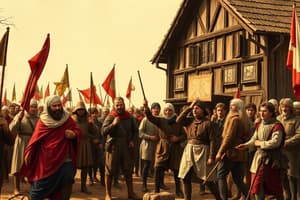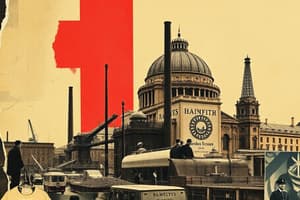Podcast
Questions and Answers
What was the most serious source of nationalist tension in Europe after 1871?
What was the most serious source of nationalist tension in Europe after 1871?
The Balkans.
How did nationalism evolve by the last quarter of the nineteenth century?
How did nationalism evolve by the last quarter of the nineteenth century?
Nationalism evolved into a narrow creed with limited ends, and nationalist groups became increasingly intolerant and ready for war.
Which region comprised modern-day Romania, Bulgaria, Albania, Greece, Macedonia, Croatia, Bosnia-Herzegovina, Slovenia, Serbia, and Montenegro?
Which region comprised modern-day Romania, Bulgaria, Albania, Greece, Macedonia, Croatia, Bosnia-Herzegovina, Slovenia, Serbia, and Montenegro?
The Balkans.
What did the spread of the ideas of romantic nationalism in the Balkans, combined with the disintegration of the Ottoman Empire, lead to?
What did the spread of the ideas of romantic nationalism in the Balkans, combined with the disintegration of the Ottoman Empire, lead to?
How did the major European powers manipulate nationalist aspirations in Europe to further their own aims?
How did the major European powers manipulate nationalist aspirations in Europe to further their own aims?
What were the European subject nationalities increasingly ready to do by the last quarter of the nineteenth century?
What were the European subject nationalities increasingly ready to do by the last quarter of the nineteenth century?
What was the common allegiance that bound the diverse groups within the Habsburg Empire together?
What was the common allegiance that bound the diverse groups within the Habsburg Empire together?
Which dominant class was socially and politically prominent in Europe during the time period mentioned in the text?
Which dominant class was socially and politically prominent in Europe during the time period mentioned in the text?
What language did the members of the aristocracy often speak for purposes of diplomacy and in high society?
What language did the members of the aristocracy often speak for purposes of diplomacy and in high society?
What tied together the members of the aristocracy across regional divisions?
What tied together the members of the aristocracy across regional divisions?
What were the Italian-speaking provinces included in the Habsburg Empire?
What were the Italian-speaking provinces included in the Habsburg Empire?
Which ethnic group spoke Magyar in Hungary during the time period mentioned in the text?
Which ethnic group spoke Magyar in Hungary during the time period mentioned in the text?
Explain the role of women in nationalist struggles.
Explain the role of women in nationalist struggles.
How did the French revolutionaries create a sense of collective identity among the French people?
How did the French revolutionaries create a sense of collective identity among the French people?
Who were Marianne and Germania, and what was the importance of the way in which they were portrayed?
Who were Marianne and Germania, and what was the importance of the way in which they were portrayed?
Briefly trace the process of German unification.
Briefly trace the process of German unification.
What were the causes of the First World War?
What were the causes of the First World War?
Discuss the significance of Balkan wars in the context of European subject nationalities.
Discuss the significance of Balkan wars in the context of European subject nationalities.
Flashcards are hidden until you start studying




